Presented here are news announcements made during the past week by the following organizations:
JADAK;
Identiv, NXP Semiconductors;
KLAS Research, CenTrak;
Cisco;
the Dartford and Gravesham NHS Trust, Current Health;
STMicroelectronics;
Decawave;
the Industrial Internet Consortium, the Openfog Consortium;
the NFC Forum, AIM, and Japan Automotive Software Platform and Architecture (JasPar).
JADAK Offers UHF RFID Smart Module for OEMs
JADAK, a business unit of Novanta, has announced the availability of its ThingMagic EL6e UHF RFID smart module for original equipment manufacturers. The EL6e, an embedded RFID solution for short- to mid-range applications, supports autonomous workflows, permitting the rapid creation of solutions. The EL6e does not mandate the use of SDKs and integration tools, and it supports an interface between applications and RFID readers known as the RAIN Communication Interface.
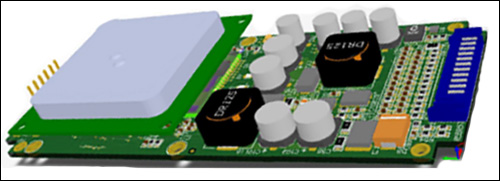
“With EL6e, we have provided a way for our customers add RFID to their workflows without having to be experts in the technology,” said Harinath Reddy, JADAK’s senior director of RFID research and development, in a prepared statement. “The EL6e is now available to ship to JADAK’s OEM customers and will be available through our distribution and reseller partner network, along with the Elara plug-and-play USB reader in March.”
The ThingMagic EL6e module and the Elara reader will be demonstrated at the RAIN Alliance group meeting on Mar. 5-7 in Memphis, Tenn. The device will also be showcased in JADAK’s booth at the RFID Journal LIVE! 2019, which will be held on Apr. 2-4 in Phoenix, Ariz.
Identiv, NXP Semiconductors Collaborate on NFC Inlay for Internet of Things
Identiv has announced a new RFID inlay in collaboration with NXP Semiconductors. Using NXP’s NTAG 210µ Near Field Communication (NFC) IC, Identiv’s Dry Inlay measures 25 millimeters (1 inch) in diameter and has been launched at a price of $0.05 per tag. Compatible with most NFC-enabled devices (Android or Apple iOS 11 and above), the inlay enables such NFC use cases as Internet of Things (IoT) and customer-engagement applications.
Identiv’s Dry Inlay design, including a chip, an antenna and an inlay, can be directly embedded in or converted into finished products. Suitable applications include the IoT, NFC smart posters and billboards, libraries, event and transportation ticketing, the automotive and chemical industries, logistics and supply chain, asset management, pharmaceuticals and health care, fast-moving consumer goods, beauty care, spirits, device authentication and counterfeit protection, electronic games, event management, wearable technology and customer loyalty programs.
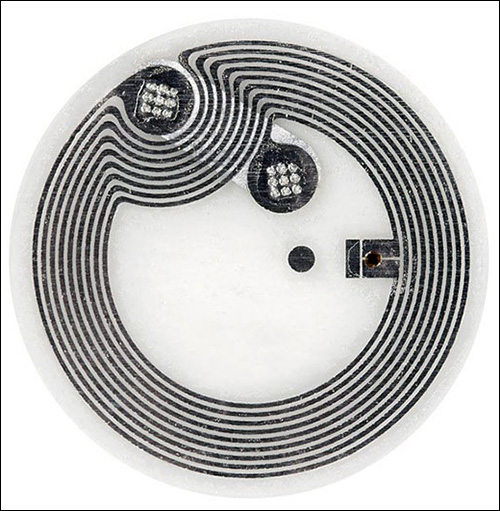
“The proliferation of NFC-enabled smartphones and other consumer electronic devices allows companies to engage directly with their end-customers. Identiv helps them make this happen,” said Manfred Mueller, Identiv’s COO and general manager for identity, in a prepared statement. “Our expertise lies in the design and production of inlay designs integrating various materials, chip technologies, and frequencies for metal and non-metal environments.”
As part of our comprehensive portfolio, we offer state-of-the-art, contactless-based inlays to guarantee superior quality performance for practically any application,” Mueller added in the prepared statement. “Leveraging the quality of NXP chips, Identiv continues to ideally position NFC for easier integration and adoption in different markets, while also allowing straightforward migration from barcodes/QR codes to powerful, flexible NFC technology.”
“NXP develops silicon-based solutions for customer needs in connectivity and smart applications – from reliable, cost-efficient implementations to more advanced, feature-rich security offerings, like our recently announced NTAG 424 DNA solution,” said Alexander Rensink, NXP’s business segment manager of smart products, in the prepared statement. “Based on the cost-optimized NTAG 210µ, Identiv’s new ultra-low-cost NFC tags are perfectly suited to companies looking to deploy quality, off-the-shelf connectivity. By working with Identiv, we further our commitment to see NFC everywhere by enabling a new generation of smart products across a wide range of end markets where NFC may have been previously considered price prohibitive.”
KLAS Research Honors CenTrak for Its RTLS Offerings
CenTrak, a provider of enterprise locating and sensing services for health care, has announced that it has been named the 2019 Real-Time Location Systems (RTLS) Category Leader for the third consecutive year by KLAS Research, a health-care IT data and insights company. CenTrak received the highest performance score of all ranked RTLS vendors, the company reports.
“Category Leaders are committed to providing the very best technology, service, and guidance to providers and payers,” said Adam Gale, KLAS Research’s president, in a prepared statement. “The Category Leader award carries with it the voice of thousands of providers and payers, highlighting outstanding vendors who have raised the bar.”
CenTrak was honored in the organization’s “2019 Best in KLAS: Software and Services” report. KLAS’s researchers collected feedback from more than 30,000 health systems and payers throughout the United States and abroad, in order to generate honest and impartial assessments regarding the performance of software, service and medical equipment vendors in the industry. KLAS added performance indicators to help provide context and transparency of product performance.
KLAS’s scores are weighted in terms of culture, operations, product, relationship, value and loyalty. The grades associated with each category provide context about how a particular software or service is performing compared to other software or services. Vendors with the Category Leader designation are considered to stand out for helping health-care organizations deliver quality patient care.
“CenTrak is honored to receive this recognition by KLAS once again, as it highlights our unique ability to elevate patient care via the application of multiple location and sensing technologies,” said Ari Naim, CenTrak’s president and CEO, in a prepared statement. “We look forward to continued innovation that will improve the patient experience through the entire continuum of patient care.”
Cisco Intros New Switches, Router for IoT Environments
Cisco has introduced its Catalyst IE3x00 Rugged Series of switches, as well as its IR1101 Integrated Services Router (ISR). These products include support for Cisco’s IOS XE operating system and include:
• New IoT networking platforms: The new Catalyst industrial switches and routers are built for IoT environments and are powered by IOS XE, an operating system that powers intent-based networking. The new platforms are managed by Cisco DNA Center, which provides a single view across a campus, branch or IoT environment.
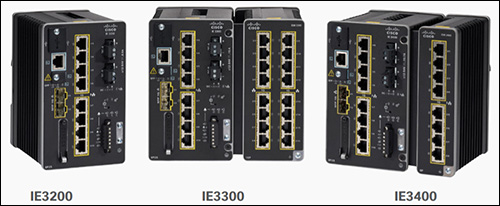
• IoT developer tools: Cisco’s developer program, DevNet, features tools to enable customers and partners to innovate at the IoT edge. Ecosystem partners can build and manage applications at the edge, providing flexibility for customers. The new IoT Developer Center comes with learning materials, developer tools and support resources for partners to begin building solutions and applications.
• Blueprints for utilities, manufacturers, and remote and mobile assets: Working with industry partners, Cisco has created three new blueprints for IoT architectures, known as Cisco Validated Designs, to enable customers and partners to accelerate from proofs-of-concept to scaled deployments
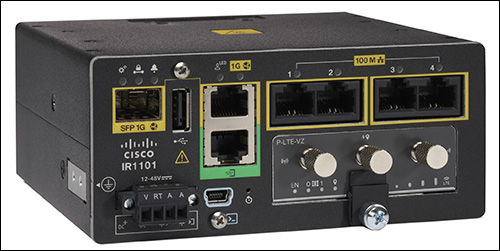
• IoT partner training: Cisco has built a global ecosystem of IoT partners by providing training and specialization programs. This ecosystem includes ISVs, machine builders and service providers, serving the manufacturing, transportation, energy, retail and public sectors.
“In IoT, the conversation is about business outcomes. It starts with secure connectivity as the foundation of every IoT deployment. By providing scale, flexibility and security, we’re turning the network into a secret weapon for our IoT customers,” said Liz Centoni, Cisco’s senior VP and general manager for the IoT, in a prepared statement. “And, with a new DevNet IoT developer center, we’re empowering thousands of partners and developers around the world to build upon our IoT platform.”
Dartford and Gravesham NHS Trust Reduces Hospital Readmissions via Remote Patient Monitoring
In an effort to keep patients safe and healthy in their own homes, the Dartford and Gravesham NHS Trust Hospital has deployed Current Health‘s AI-enabled wearable platform to remotely monitor discharged patients. By analyzing real-time health data collected by Current Health, Dartford and Gravesham’s clinicians and staff members have reprioritized home visits based on criticality, resulting in a 22 percent reduction in home visits, while freeing up skilled nursing time and resources.
Serving more than 500,000 people, Dartford and Gravesham is among the largest hospital trusts in North Kent, England, and its goal is to increase care closer to home in order to improve patient outcomes. Dartford and Gravesham selected Current Health as its remote patient monitoring (RPM) deployment partner because it sought to use wearables and sensors to help patients avoid hospitalizations, minimize readmissions and reduce emergency department visits.
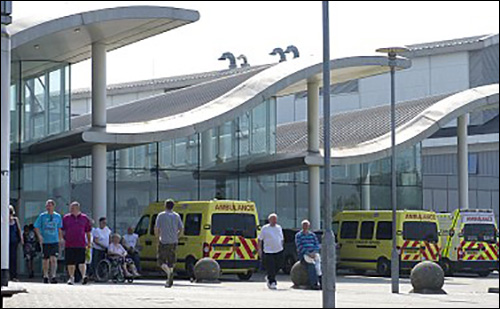
The facility’s Hospital at Home team was trained to use the Current system in less than an hour, and were monitoring patients within 24 hours of deployment. The solution alerts the team if a patient’s health shows signs of deterioration, providing an early-warning system to provide faster intervention and prioritize patient needs. The Trust achieved a 92 percent patient adherence rate, which is above the typical industry rate of 50 percent, with patients reporting that they felt safer and more secure.
“The value of Current was demonstrated in our very first patient – a chronically unwell patient who suffered a decline in oxygen saturation, which Current detected sooner than standard care would have caught it, letting us intervene earlier and in the patient’s home,” said Neil Perry, Dartford and Gravesham’s CIO, in a prepared statement. “With Current, we’ve seen the ability to deliver intervention at a far earlier point and prevent hospital readmission.”
The Current device is worn on a patient’s upper arm, where it continually and passively collects vital signs with ICU-level accuracy to provide an automated picture of human health. Its proprietary artificial intelligence platform analyzes patient data, offering actionable and proactive insights into the wearer’s health.
The Hospital at Home service comprises a multidisciplinary team of nurses and physiotherapists experienced in managing complex patients at home, including those with cardiovascular and respiratory diseases like chronic obstructive pulmonary disease. The team identifies which patients can be appropriately managed at home, then links them to the Current system. Patients are sent home with two Current wearables: a Homehub and a charger. They can then plug in the Homehub to receive in-home Wi-Fi service and securely transmit data across the cellular network.
“Dartford and Gravesham is an exemplary hospital committed to improving the complete patient healthcare experience, with both clinicians and patients alike benefiting from such a proactive approach,” said Christopher McCann, Current Health’s CEO, in the prepared statement. “Not only was preventative care made a reality for patients far earlier than standard care expectations, but patients reported feeling safer and more secure wearing the Current device—this is one of the greatest benefits we can ever expect to realize as a team.”
STMicroelectronics Unveils Energy-Efficient Step-Down Converters for IoT Devices
STMicroelectronics has announced that its ST1PS01 step-down converters are engineered for low-quiescent current and high efficiency, to help companies save energy with point-of-load supplies and Internet of Things (IoT) devices, such as asset trackers, wearables, smart sensors and smart meters.
Leveraging synchronous rectification, the device provides efficiency of 92 percent at 400mA full load and 95 percent when delivering 1mA, the company reports. Its design features keep the quiescent current to 500nA and include a low-power voltage reference. It comes with a pulse-frequency counter for controlling converter current at light load, with two high-speed comparators to help minimize output ripple.
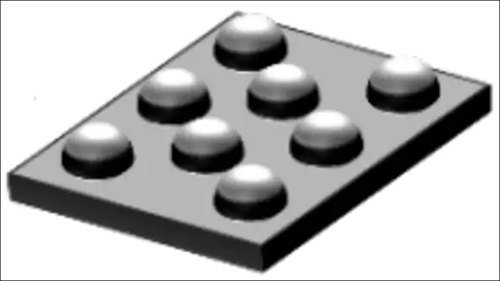
Integrated feedback-loop compensation, soft-start circuitry and power switches are provided, and the typical inductor value is 2.2µH. Output-voltage selection logic saves external voltage-setting components, while providing the flexibility required to configure modules digitally at the point of manufacture, or to let a host system change the output voltage on the fly. Eight variants, each with four optional output-voltage settings, allow a choice of regulated outputs, ranging from 3.3V to 0.625V. All models feature a Power-good indicator.
The input-voltage range is from 1.8 to 5.5 volts, increasing flexibility for designers by allowing various battery chemistries or configurations, as well as extending runtime as the battery discharges. ST1PS01 regulators are suitable for devices powered from energy-harvesting systems and feature a low noise-architecture that allows use in noise-sensitive applications.
An evaluation board, model STEVAL-1PS01EJR, helps developers to utilize the ST1PS01’s high energy efficiency and feature integration, according to the company. The ST1PS01 regulators are now in full production, packaged as 400µm-pitch flip-chip devices measuring 1.11 millimeters by 1.41 millimeters (0.04 inch to 0.06 inch), and are priced from $0.686 for orders of 1,000 pieces.
Decawave Provides Secure Mobile Transactions for Consumer Devices via UWB Chipsets
Decawave, a provider of ultra-wideband (UWB) semiconductors, has announced its latest UWB chipsets, which were designed to meet the global need for increased mobile transaction security. The new chipsets will support the IEEE 802.15.4z (4z) standard, currently in the final stages of development. The chips utilize a new version of the 802.15.4z UWB standard.
“Today’s mobile devices do an amazing job of combining multiple capabilities into a single device. However, as they increasingly act as the central hub for our lives, it is clear the next generation will need dramatically better security around digital wireless transactions to combat increasingly sophisticated attackers,” said Ciaran Connell, Decawave’s CEO and co-founder, in a prepared statement. “Our new 4z based chips enable a step-change in security for home and auto access, financial transactions and many other uses across smart cities using smartphones, wearables and other connected devices. Thanks to our strong position in standards and early investment in R&D, Decawave customers will be first to get access to the capabilities included in the new 4z standard as we will be able to quickly roll-out different variants of the new chipsets starting in 2019.”
Based on a new platform, the chipsets offer power consumption reduction over current technology, the company reports, and support the 8 GHz band (Channel 9), enabling worldwide operation. Derivatives will be available to address the needs of mobile, automotive, consumer and industrial customers. The new 4z standard has been developed as a complement to the current Decawave-driven 4a standard (802.15.4-2015), in order to meet meets the increasing need for secure, high-precision location awareness and location services. Among the applications enabled by the secure ranging technology in the 4z standard are highly secure mobile financial and access transactions, as well as the ability to use precise location to combat malicious attacks that enable the hacking of wireless payments and the theft of modern vehicles.
Industrial Internet Consortium, Openfog Consortium Unite
The Industrial Internet Consortium (IIC) and the OpenFog Consortium have announced that they have finalized details to combine their efforts. The two organizations will work together under the IIC umbrella to drive the momentum of the Industrial Internet, including the development and promotion of industry guidance and best practices for fog and edge computing.
This announcement brings OpenFog members into the IIC at a time when their complementary areas of technology are emerging in the mainstream, the organizations report. The first formal meeting of the unified organization will be held in Raleigh, N.C., on Feb. 11-14. The IIC has also announced that the IIC Steering Committee, which guides the strategic direction of the organization, has elected two OpenFog principals:
• Ron Zahavi, Microsoft’s chief strategist for IoT standards, is focused on IoT standards and consortia, and leads Microsoft’s Worldwide IoT Architecture Community. He has experience in all aspects of technology management and solution delivery, including IoT solutions. Matt Vasey, Microsoft’s director of AI and IoT business development, will serve as Zahavi’s alternate.
• Mung Chiang, Purdue University’s John A. Edwardson Dean of the College of Engineering, was previously the Arthur LeGrand Doty Professor at Princeton University and founded the Princeton EDGE Lab in 2009. The lab bridges the theory-practice gap in edge computing and networking research by spanning from proofs to prototypes. Chiang received the 2013 Alan T. Waterman Award for his contributions to networking R&D.
“This agreement brings together the two most important organizations shaping the Industrial Internet of Things. The combined organization offers greater influence to members, more clarity to the market, and a lower-risk path to the future for end users. We will be the center of gravity for the future of Industrial IoT systems across industry verticals,” said Stan Schneider, the IIC Steering Committee’s CEO of real-time innovations and vice-chair, in a prepared statement. “We welcome the experience and vision that Ron Zahavi and Mung Chiang bring to our Steering Committee.”
“We are excited to take the first steps toward integrating the OpenFog Working Groups, Testbeds and Use Cases with those of the IIC,” said Matt Vasey, OpenFog’s chairman and president, and Microsoft’s director of AI and IoT business development, in the prepared statement. “Our membership is highly motivated to contribute at every level to continue the advancement of fog technology in the Industrial Internet.”
NFC Forum Signs IoT Liaison Agreement With AIM, Expands Automotive Partnership With JasPar
The NFC Forum, a global standards and advocacy association for Near Field Communication (NFC) technology, has announced the signing of a liaison agreement with AIM, along with the expansion of an existing relationship with the Japan Automotive Software Platform and Architecture (JasPar) organization.
The AIM liaison agreement focuses on the Internet of Things (IoT) market, furthering an NFC Forum objective to partner with complimentary technologies to use NFC to help connect, commission and control the 36 billion IoT devices predicted to be be in use by next year. The JasPar relationship was enhanced to allow the two groups to work more closely together to expand the use of NFC in the automotive market. JasPar recently started a Digital Car Key group within the organization as a target application for NFC.
“The IoT and automotive markets are rapid growth areas for NFC technology,” said Paula Hunter, the NFC Forum’s executive director, in a prepared statement. “The agreements with AIM and JASPAR are joint opportunities to work with new technologies and develop interoperability use cases to promote the use of NFC in IoT and automotive applications worldwide.”
AIM and the NFC Forum will work together to mutually educate the market and help build the ecosystem for NFC for IoT and industrial applications. AIM is an industry alliance that represents organizations that use, implement, resell or develop bar-coding, RFID or mobility technologies. The alliance enables adoption, growth and interoperability related to automated data-capture technologies and the enterprises that use this technology in the marketplace.
JasPar is an automotive association tasked with standardizing and improving electronic control system software and in-vehicle networks. This agreement deepens the existing partnership between JasPar and the NFC Forum to include the co-development of NFC automotive use cases and requirements, the co-creation of non-technical documents, and the sharing of technical documents and specifications. “AIM is excited to be part of this new partnership,” said Mary Lou Bosco, AIM’s COO, in the prepared statement. “Each organization has unique perspectives and industry expertise that will be valuable to this relationship.”

